Star Trek Adventures by Wikipedia Brown
Part 1
Original SA post
Part 1
Hey, it’s Star Trek, a beloved, adventure-filled setting that has always seemed like a great place for gaming, yet it in practice, it appears to be notoriously difficult to make a game that really plays to the strengths of the franchise. Did the weirdos at Modiphius Entertainment pull it off?
Let’s find out!
Right off the bat, I appreciate their approach to short fiction. Rather than the customary introductory story that I’ll never read, the book is instead sprinkled with in-universe tidbits. These take various forms, such as captain’s logs, space emails, transcripts, intercepted intelligence, etc. I’ll read at least some of those! They’re brimming with references to Trek lore both major and obscure.
The earlier, scene-setting chapters are packed with them, and they taper off as you get into the more reference oriented material. (If you’re just trying to see how much latinum you can get for a Mugato horn on the black market, you’re probably not going to stop to read Geordie LaForge’s Myspace post about Hanzo steel.)

They went full LCARS, because of course they did.
We begin with a few generalities about the setting, and the usual “Game and game! What is game?!” discussion.

A default timeframe is generally assumed throughout, and I’ll quote the book here, because it does a good job of framing it (if you’re a nerd):
quote:
It is an exciting time in Starfleet’s history — Earth Year 2371. The U.S.S. Enterprise NCC-1701-D will be sent on a mission to the Amargosa observatory, U.S.S. Voyager NCC-74656 is about to be sent on a mission into the Badlands to search for a Maquis ship, and the U.S.S. Defiant NX-74205 has been assigned to Commander Sisko at Deep Space 9 to assist in the search for the Dominion in the Gamma Quadrant.
So, right around Star Trek: Generations, what a time to be alive.
A sidebar explains that they intend for it to be easy to play in any era; when the book references technology, like a ship or gadget, it includes a relevant note. It also promises to go into more detail about running games in other times in the Gamemastering chapter, and then further in later supplements.
There is a roundup of the needed materials, followed by a very brief introduction to the basic 2d20 mechanic. It then jumps into a mechanically dense example of play that I found pretty confounding based on the cursory look at the game’s systems provided up to this point. People are gaining and spending Threat and Momentum and rolling Challenge Dice and all this crap, and I have no idea what it means.
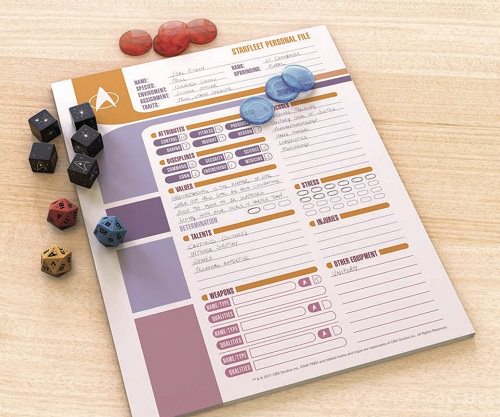
what is all this shit? Also, it’s personnel file. (They got it right on the final character sheet.)
The system is derived from Mutant Chronicles, and used in a few other games like the Infinity RPG and some Conan thing, none of which I’ve played. If anyone has feelings about the system, I’d love for you to chime in!
Next: A ton more pages detailing the setting, which I'll mostly skip over, because it's Star Trek, duh.
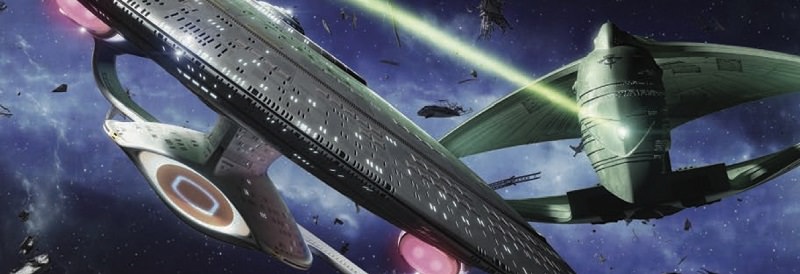
Part 2
Original SA post
Part 2

Here's where we find out who's who and what they're all up to.
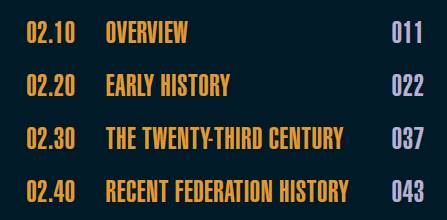
The first subsection has a lengthy overview of the various players in the galaxy, and the subsequent parts detail the state of things in their respective periods. Those in-character fiction bits are out in crazy force, here. In fact, Early History and Recent Federation History are made up entirely of these boxes, making for a very unpleasant layout.
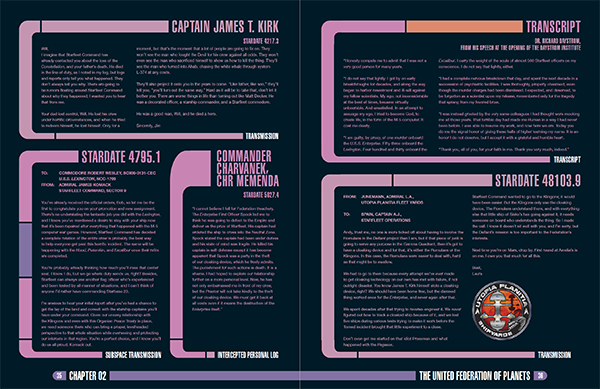
this is a bit much
It's the usual stuff, like the personal log of a Pakled captain planning an excursion through the Bajoran wormhole in order to loot new civilizations in the Gamma Quandrant.

what could go wrong?
At first blush it seems like a lot of ink to spend on shit we could look up on Memory Alpha, but they make smart choices about what is likely to come up in a game, and they put it into useful context. If you do use Memory Alpha, you can too easily fall down a 45 minute hole reading about Earth foods and beverages.
Instead, here we have reasonably brief introductions to the various factions in the Alpha and Beta Quadrants, and then a grab bag of others, like the Dominion, The Q, the Borg, and even the Terran Empire (from the mirror universe, which, as stupid as the whole concept is, has amazing potential in a campaign). The focus is largely on threats to the Federation, with a few exceptions.
One that jumped out at me was the Nyberrite Alliance. Apparently it's some entity that was barely mentioned in an episode of DS9. It seems like a weird inclusion, but it's nice to have a potentially major ally that hasn't been fleshed out to death in other media already.
While the main text is from the Federation perspective (in character as someone giving a fresh captain a rundown of the state of the galaxy), the boxouts here tend to give a view of the Federation through the eyes of an outsider organization, like the Orion Syndicate (green space criminals) and the Tal Shiar (Romulan CIA).
This chapter seems like a nice way to get a refresher on some faction that you're thinking about incorporating into a game. If you were, say, new to Trek and wanted to get up to speed on what's what... well, I think it's kind of a slog. To be fair, I don't think there's a good way to dump all of this information out there, and they do try to give it some character. The section on the 23rd century sets a nostalgic tone in going over the accomplishments of Kirk and co., and it addresses the contrast between the Wild West of the Original Series and the more measured approach of "modern" Starfleet.
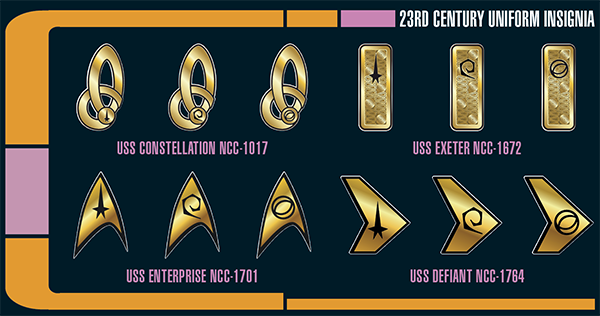
In the end, it's Star Trek. If you're running this thing, you and your players probably have your own ideas of what the cool bits are.
I'd like to close this entry on a general note about the art. There's the usual painted stuff showing locales, characters, ships and the kinds of action they get up to. It's all good! It can look slightly weird when it's the likeness of an actor we've been staring at for years, but I have no complaints.
What I really enjoy are the vector illustrations throughout, which are styled to look like something that would be on a computer display in one of the shows, or to make things like service patches and other logos. If you're reading the PDF version, it's fun to zoom way in on 'em. (And it would be a great place to steal a high quality image of a badge or something.)
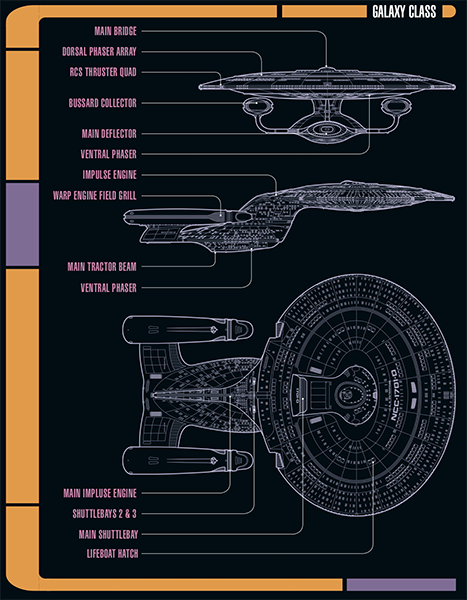
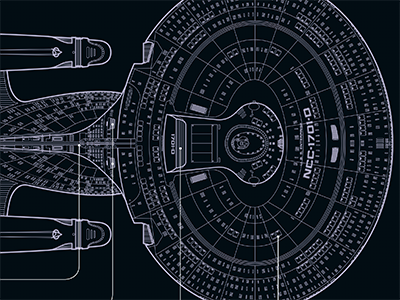
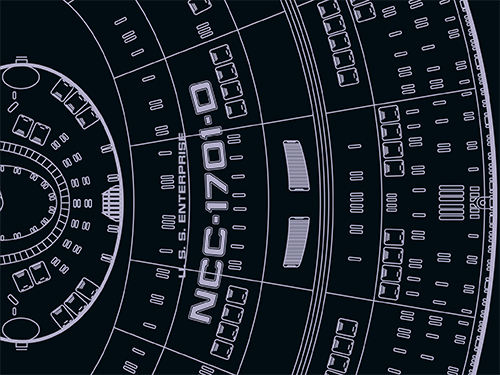
This looks like a labor of love to me.
Next time: a deep dive into the Starfleet experience
Part 3
Original SA post
Part 3

OK, let's try to keep on (space) truckin' through this shit.
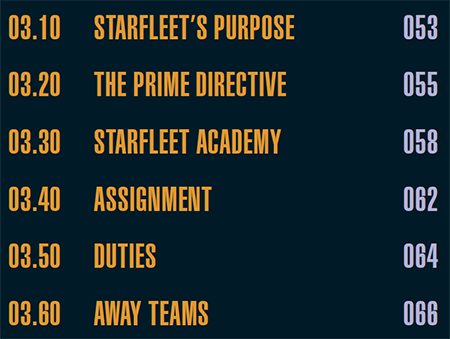
Starfleet's Purpose gives a basic rundown of what Starfleet is and how it's organized. You got your exploration and your science and your defense; it tries to make a the semi-militaristic and scientific natures of Starfleet meld together naturally, and I think it works. The idea is that we're flying around looking to meet new people and take selfies with space anomalies, but we know that there's danger out there, so we have to be prepared for the worst.
Then there's a brief description of who's in charge of what, between the council, the CIC and the admirals, etc.
The Prime Directive is not going to be news to any of you nerds, but they take a smart tack by emphasizing that there are often good reasons to go against it and intervene in various situations. Because, just like the show, that's obviously what you'll be doing in the game, unless you want to spend a session wringing your hands and then just flying off at the end. Through a boxout, they do acknowledge that some take the Prime Directive as gospel, but it's presented as an extreme view.
Next is a section that reads like a college brochure, describing the goals and methodology of Starfleet Academy. It continues the trend of being well-written, if not revelatory. Another continuing trend is the frequency of fun nods to series continuity, like a brief discussion on the idea of unmanned exploration missions which namechecks the vessels involved in the events of “The Ultimate Computer.” I’d probably recommend that players read this section, because it gives a feel for how a cadet might be shaped by their experiences at the academy.
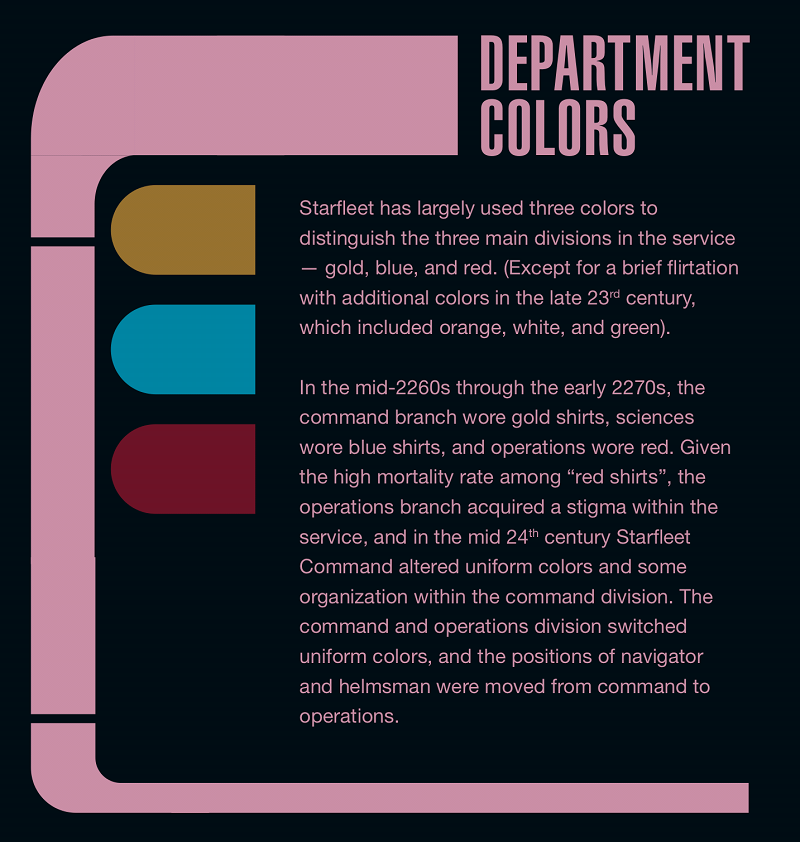
amusing
Following graduation, the next step for a cadet is Assignment to one of the Starfleet divisions, and more specifically, a position somewhere, probably on a starship. That ship will have an ongoing mission, which will be broken down into smaller individual missions, which comprise the various Duties expected of a Starfleet ship, some of which may involve Away Teams. In these sections, we get kind of a cheat sheet of the kinds of shit you'll be sent off to do. Of course, in many episodes of televised trek, the stated mission is simply a way to get your ship headed somewhere for some unrelated bullshit to happen along the way, so if you're going for a TV feel, I personally wouldn't worry about the actual details of who you're supposed to be delivering supplies to or whatever.
NEXT TIME, ON STAR TREK ADVENTURES we finally get into the actual game and see how task resolution works! It involves dice.
Part 4
Original SA post
Part 4

OK, how does this game actually work?
First we get the usual explanation of the difference between PCs and NPCs, but with a twist: here is the first hint about the difference between Main and Supporting player characters. Having more than one PC available to a player is not an original idea, but it is uniquely useful in addressing one of the problems of running a Trek game that resembles the on-screen action. We'll get into it in detail in the next chapter, but you can probably already see the fundamental advantage. There's no more twiddling your thumbs while your character is back on the ship studying Rigelian herpes while the other players are having all the fun on an away team; you can join in the action with a lower rank crewmember. You can split the party up and still have all the players playing. Love it (assuming they keep the bookkeeping to a minimum).
A rumination on the relationship between players and GM gives off a kind of Apocalypse World vibe:
quote:
Above all else, the Gamemaster is not an adversary to the Players — the game works all the better if the Gamemaster is a fan of the Player Characters and their exploits, albeit one who seeks to make those characters’ lives as dramatic, exciting, and challenging as possible.
Another similarity is the use of Traits, which are described in similar terms to Apocalypse tags, in that they are descriptors that can be attached the people, places and things that follow a certain narrative logic. At a systems level, they tend to either negate certain actions or adjust a task’s difficulty either positively (Advantage) or negatively (Complication).
Let’s not get too excited about the narrative-style elements; at this point my broad impression is still that we’re dealing with kind of a medium-crunch simulationist game straight out of the 90s. It seems like they’ve at least read other kinds of stuff, though I don’t know how much of this was already a part of the Mutant Chronicles dealie. I’m starting to think I have some research to do.
Dice and Task Resolution
Alright, buckaroos, it’s time to talk turkey. I'm struggling a bit to find an order in which to introduce the gameplay systems, just as I think the book struggles as well. There's an awful lot of "we'll explain this in more detail later." Let's talk about some fuckin' dice.
We got your d20s for doin' stuff, and your d6s for rolling on tables, and "challenge dice" for damage.
Basic task difficulty is a weird hybrid system, where a character's proficiency and the circumstances they're up against are measured on two different axes:
-An Attribute (like Reason) and Discipline (say, Medicine) most relevant to the task are added together to get a Target Number (TN). The player rolls 2d20 (more with expenditure of Momentum, which we'll get to later), and each die that shows a value less than or equal to the TN counts as a success. You get an extra success if you also roll under the Discipline rating and have a relevant Focus (Nausicaan Proctology?) within that Discipline.
-The GM decides on a difficulty, which is the number of successes needed to complete the task. (Overachieving on this is one way to get Momentum for later rolls.)
So the number of dice rolled, the number you're trying to hit and the number of hits you need are all three in flux. My initial kneejerk reaction is that I hate this. We'll see how we feel as we get into more detail later.
But wait, there's more! Challenge Dice! (I had to jump to about half way through the book to see what these do.) These also have six sides, but instead of numbers from 1 to 6, they have maybe a 1 or a 2 or a Starfleet logo or nothing on a given side. These are generally used for damage rolls, and you roll a bunch based on the weapon or whatever, then you add the numbers together to determine damage. The logo side also adds one to the total, and triggers any special effects that your attack is capable of, like, say, a knockdown.
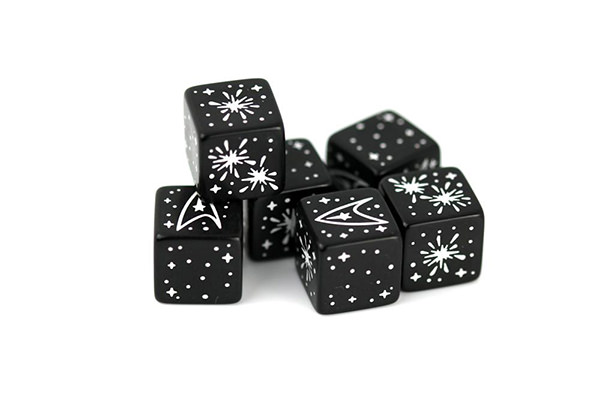
let's just add a ton of visual noise by putting a starfield on each side, that'll improve readability
I'm not loving this, either. First of all, the name Challenge Dice doesn't mean anything. Secondly, it's a goofy-ass die. It was a bit weird when we first encountered dice like this; for me it was in WFRP 3rd edition, and then later in the FFG Star Wars stuff. But that weirdness turned out to be in service of a pretty elegant solution that consolidates attack, defense, damage and special crit-style effects into a single roll. Here, we get the wackadoodle dice (that they want you to buy), but it doesn't really seem to reduce overhead.
For a system that wants to be pretty cinematic, it sure comes off as a fiddly mess. We're jumping ahead, though. Let's back it up and talk more about Momentum and Threat and oh god there's another pool called Determination.
Momentum: You collect it from rollin' good and other stuff like Talents. You spend it for more dice, or to upgrade a success to confer an Advantage, or to bump up an opponent's difficulty, or to get info about something.
Threat: It's the same shit, but for the GM to use against the players.
Determination: It's another thing you can spend to make good things happen, and it's related to your Values, which will be described later. It's like what you're about, and you're rewarded when it plays into the action, and there's stuff revolving around your values hindering you or you challenging them.
Finally for this chapter, there's a section on things like extended tasks, and Challenges that are composed of a series of tasks, with a few wrinkles, like working against the clock. It feels pretty Star Trek. Like there's a plan, and you'll have to tech the tech first, while someone else creates a diversion. If you tech the tech especially well, you'll get an Advantage in some opposed check to trick the enemy sensors, while a good diversion will buy more time.
Like a lot of stuff in this game, it's coming up with a lot of terminology for something that you'd just do naturally in the course of roleplaying, anyway.
Next time: character creation.
Part 5
Original SA post
Part 5

05.10 A CAREER IN STARFLEET
Time for a rundown of the various elements of a PC. We already mentioned the effects of Traits and Values (examples could be Vulcan and The Needs of the Many &c., respectively). Let’s get to the good shit, though, because I know the first thing you look at when you check out a new game is the character sheet, and the first thing you look at on the character sheet is the primary attributes.

I mean, I’m always jazzed to see how many ways people can come up with to cover the same basic stuff. Will they try to be original and dig around in the thesaurus to find a never-before-heard way to say “strength,” or will they go more tried and true? I can tell you right now that we’re dealing with some twisted freaks, because these shits be in alphabetical order.
Control governs “precision, accuracy, and careful timing.” This applies to both mental and physical tasks. So, this would be good for playing Operation or trying not to laugh at your commanding officer.

It’s also useful “to resist mental assault... through an orderly mind and the application of discipline.
Daring relates to more aggressive actions, and for those situations where you need to take action decisively without dithering about it for 40 minutes in the ready room.
These are feeling a tad esoteric, but I can see how it works with Trek character archetypes. You can easily categorize major Trek people by how controlled or daring they are.
And this one is handy if you have to “resist mental assault, fear, or panic through stubbornness and defiance.” This is starting to seem silly, but to be fair, motherfuckers get mind-controlled almost every week in the world of Star Trek, so I guess it makes sense.
Fitness is the physical one.
Insight relates to empathy and, I dunno, folksy wisdom.
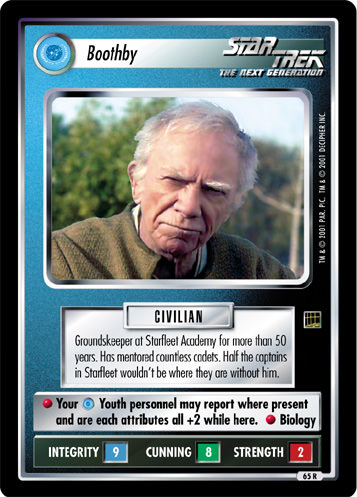
Presence denotes one’s ability to be commanding or authoritative, but also “charming or seductive.” Plenty of games have a presence or charisma attribute, but it strikes me as something that will come up more often in Trek than most settings. I guess in Vampire as written we were supposed to be having debates about the price of blood or whatever, but in reality we mostly reenacted the club scene from the beginning of Blade.
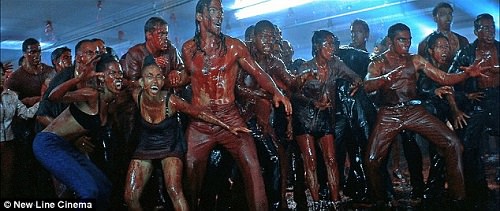
Reason is your more straightforward intelligence stat. Analyze the data and come up with a hypothesis.
So that’s one component of the Target Number; let’s move on to the other:

There are six Disciplines: Command; Conn; Engineering; Security; Science; Medicine.
The general purview of each is self-explanatory, but they include examples of how they can combine with all of the six Attributes. Some of them are a stretch or pointlessly broad. There’s also so much overlap that it seems like there will be a real lack of differentiation between characters.
In a way, it makes sense, since Starfleet officers are trained in everything, so they should all be generalists to a degree. The problem here is that they spill a ridiculous amount of words on all these stats and their combinations to arrive at a fuzzy system where anyone can justify using any stat for any action if they come up with a creative way to say it.
Like, pick one. Either make it a rules-light system and save yourself some ink, or make it a complex interlocking matrix of abilities that actually do something. Maybe I'm being too harsh, but I always find the "here's the thing I want to do, now let's all have a pow-wow on which of my stats makes the most sense for the roll" conversation to be an annoying lull that the game design should try to avoid. And it can be avoided by either having a lot of specific skills, or easy catch-all categories. This is definitely in the middle somewhere.
Maybe the next bucket of nouns will do the trick!

A main character will have six focuses. These are sorta like skills. At first I read it as similar to a specialization within a skill in something like Vampire, but these aren't tied to a particular Discipline, so it's another case of encouraging players to weasel them into any and every roll.
The way these come into play is by adding another tier to the Target Number. Normally, you add an Attribute and Discipline together to get the TN (which you are trying to roll under), but if you have an applicable focus, you’ll get a bonus success on every die that rolls not only under (or equal to) your TN, but also under (or equal to) just your Discipline. (This is basically broadening the likelihood of the bonus success conferred by rolling a 1.) Great, more stuff to hold in your mind when rolling.
They encourage you to invent these, but give a meaty list of examples.
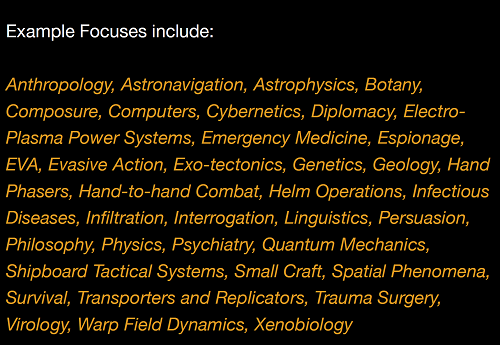
OK, I feel like I'm griping a lot, but these vary too much in specificity. Computers can be worked into practically anything. Not so much for Botany.

Here, the book briefly touches on Talents, which are the same as Talents in WFRP or Advantages in GURPS. They're extra special abilities that'll give you stuff like "extra d20s, re-rolls, bonus Momentum, the ability to use a different Discipline in a situation, and so forth." Hey, maybe these will provide the differentiation I've been craving! I guess we'll see 35 pages from now.
This chapter is gargantuan, so I'm going to split it up. Next time, we'll get into the two methods of character creation, Lifepath Creation and Creation in Play.
edited to add a picture from Blade
Part 6
Original SA post
Part 6
Let’s unabandon this shit! (Note to inklesspen, my username used to be Wikipedia Brown.) I really ran out of steam when I realized that I don’t like this system, but fuck it, I’m going to finish what I started. Who knows, maybe it’ll be a story of redemption, like that Klingon episode called Redemption. I’m going to start breaking these up into smaller chunks, and I’m going to lay off the graphics a bit. That shit is time consuming!
Chapter 5, continued
Last time, we talked about the generalities of what comprises a player character in this game. Now, we’re getting into some of the steps to actually make one of these jerks. There are actually two methods: Lifepath Creation, and Creation in Play.
05.20 LIFEPATH CREATION
This isn’t a new idea. You’ve seen it in Traveller and the Mechwarrior RPG among other places. In this case, it’s nowhere near the complex flowchart of life events that you’d get in the former (and you can’t die in the process); it’s more of a short questionnaire to take you through the standard steps of character creation.
I think it’s well-organized, and would make things less intimidating for someone new to RPGs than the usual stat buffet. Even if you don’t know what the stats do, you’ll have a gut reaction to whether you want your character to be a Vulcan from Vulcan with a Starfleet family legacy, or a Human farmer from a remote colony. Or, you can roll for everything and see where it takes you.
Each little decision adds a few things to your overall stat package. The first one is a biggie: species. There are eight examples provided, with a rule for mixed heritage characters, and some guidelines for creating your own species. (Naturally, you can expect to find more in other supplements.)
Your species gives you a bump to three Attributes, a Trait (which is just a catchall for the various quirks of your species) and a choice of one Talent out of a list of two or three. For example, if you’re a Vulcan, you get +1 to Control, Fitness and Reason. The Vulcan trait reads:
quote:
Due to the harsh, arid, high-gravity world they come from, Vulcans are naturally resistant to extreme heat and dehydration; they are also extremely strong, with keen auditory and olfactory senses. They are also telepathic, though this takes training to properly manifest, and they learn mental discipline and emotional control from childhood. However, this control takes regular meditation to maintain, and their controlled nature and desire for privacy can distance them from others, and make interactions awkward.
The available Talents are Kolinahr (lets you resist mental attacks more easily), Mind-Meld and the Famous Spock Neck Pinch.
After your species is sorted, you determine the type of home you come from, the nature of your upbringing and your course of study in the Academy. Then you get to choose whether you are a young officer, an experienced officer or a veteran officer. Experienced is sort of the default, while the others give special talents:
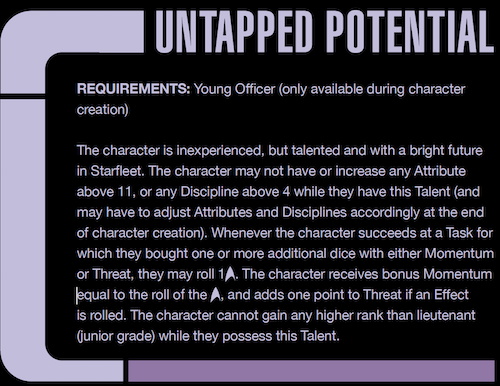
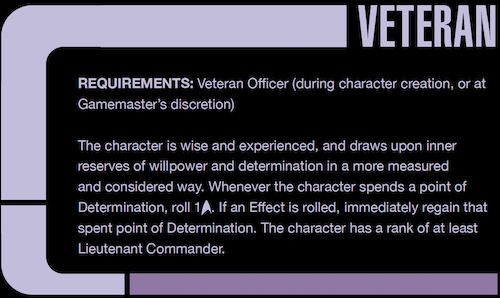
Finally, you get to roll a couple of times on the fun table:
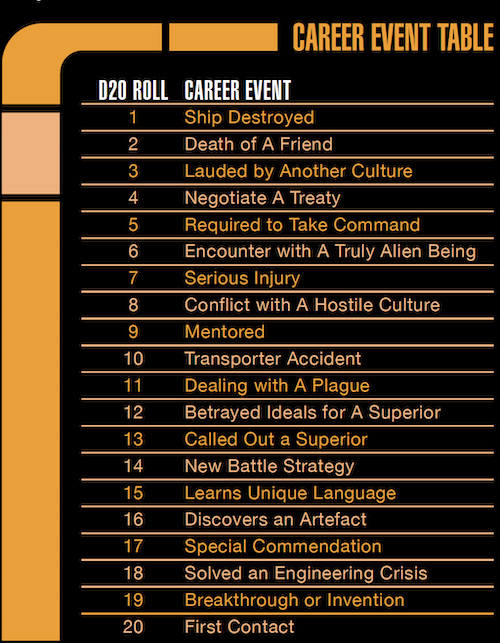
By the time you’ve applied the effects of all these dinguses, your sheet is looking pretty differentiated, with a bunch of bonuses spread around, and some special Traits and Talents and Values.
At the end of all this is the Finishing Touches section, where we get to shift Attributes around a bit to taste, pick a final Value (here’s one for free that I just came up with: “When Pizza is on a Bagel, You Can Have Pizza Anytime”), outline an appearance and personalty, pick a name, and also by the way I guess your rank and role on the ship.
It seems a bit odd the way your job is wedged in at the end, though it makes sense that you’d want to choose it after going through the rest of the lifepath stuff, now knowing where your strengths are. It’s pretty obvious stuff, from Chief Engineer to Science Officer to Ship’s Counselor, and each has a mechanical benefit (which acts basically as yet another Talent).
Rank:
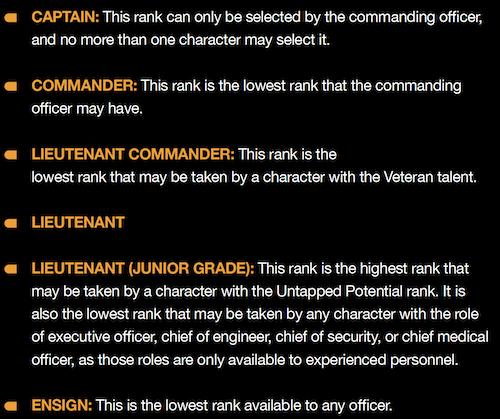
Congratulations, you made a person. I haven’t run through it myself, but it doesn’t seem too bad. Characters in this game seem to be a pretty unwieldy pile of numbers and Nouns and Adjectives, but at least the lifepath gives it to you in digestible chunks, so you’re never overwhelmed with options.
05.30 CREATION IN PLAY
Creation in Play is an alternative method, where you start with your role and a basic skeleton of a character, and then you fill out the rest during play (they suggest starting with a simple mission for everyone to find their footing). During play, if you need to fix a computer, you can be like “I’m smart and good at computers!” and, voilà, you’re good at computers. It’s kinda like having a gizmo in Toon or GURPS.
I like this as an idea to hit the ground running, but I worry that you’d get hung up a lot when it comes time to define abilities mid-game. Like, maybe don’t play this way with people who agonize over everything.
There we are! Alright kids, next time, let’s rap about Supporting Characters. I think they’re pretty hip!